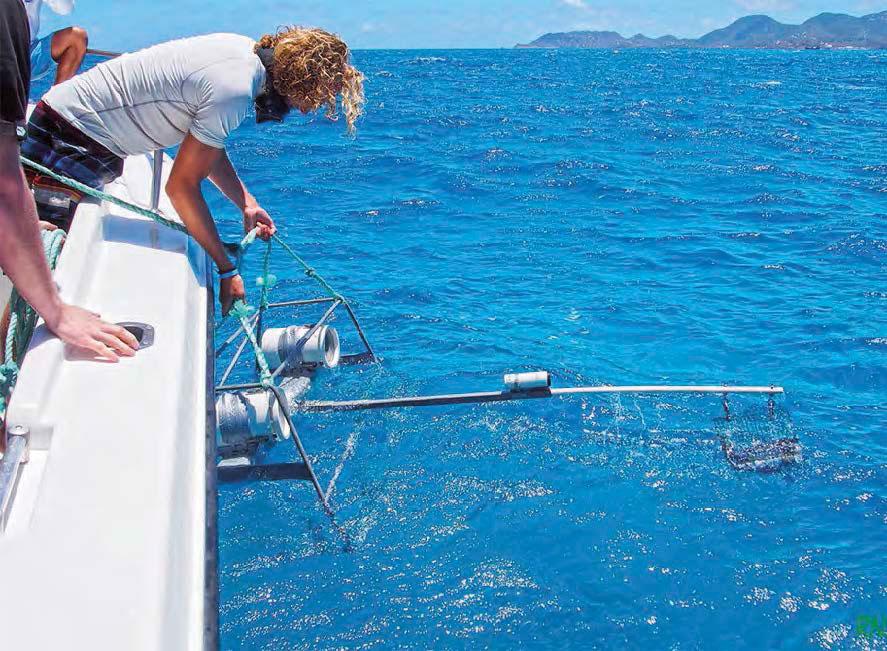The Réserve de Saint-Martin, which since 2014 has led the Project Negara study of lemon sharks, hosted a group of Dutch scientists working with the Marine Park of Sint Maarten, on April 21 and 22, 2015, along with Tadzio Bervoets, the Park director. The two academics were with consultants on assignment by the Dutch government, in order to increase knowledge about the marine zones in the Dutch Antilles, with a special focus on the identification, distribution, and management of sharks and rays. After working in Saint Eustatius and Saba, this team spent two months in Sint Maarten, where they sampled 150 points in the sea and observed numerous Caribbean reef sharks and nurse sharks. Knowing that lemon sharks and tiger sharks had been found in the waters around the French side of the island, the Marine Park contacted the Réserve Naturelle, which lent its expertise to the study by suggesting 18 observation points. The technique used by the Dutch comprised submerging two cameras that recorded in stereo and filmed everything that passed in their field of vision, with bait attached on a telescoping pole to attract these large predators. This means of recording allows for a precise measurement of the size of the sharks, and provides information about the stage of development of the species filmed. Over the course of two days, aboard the boat belonging to the Réserve, three systems of two high-definition cameras were submerged for one hour, pulled out of the water, and then re-submerged at another point, on so on. The Dutch and French each worked on their respective projects : the Dutch concentrating on an inventory and diversity of the various species; and the French continuing their study of the lemon shark, to acquire additional expertise in the manipulation of these individuals. The images recorded will be examined, with the data collected used to enrich global knowledge about sharks. «There are sharks in the waters around Saint Martin that pose absolutely no danger and even signify the good health of our ecosystems. They represent an interesting subject of observation for divers, as the sharks are furtive but not very fierce. But we must not forget that these are wild animals and they should never be fed,” explains Julien Chalifour.
Mise à l’eau des caméras Drowning of the cameras
All articles from: Newsletter-23
Reinforcement On A Regional
- 1 : Edito Journal 23
- 2 : Megara 2015: a 12-day study of humpback whales
- 3 : A beautiful book in the works
- 4 : Increased awareness of underwater biodiversity
- 5 : Challenge: treat gray water and protect the salt ponds
- 6 : Babit Point 100% Nature
- 7 : La baie de l’Embouchure “Galion Beach”
- 8 : Turtle Atlas Updated
- 9 : 17 moorings in good shape at Tintamare
- 10 : Fish Day: collaboration between the COM and the RN
- 11 : He who fishes in the Réserve cleans the beaches
- 12 : Two poachers show their regret
- 13 : The first Acropora sp. coral nursery
- 14 : The BioHab project honored
- 15 : Thanks to the employees of EME!
- 16 : Everything you want to know about humpback whales
- 17 : «My School, My Whale» project in Anguilla
- 18 : Temporary occupation of land granted by he Conservatoire
- 19 : Scientific division grows
- 20 : Cooperation for improvement
- 21 : BEST: Europe in the overseas territories
- 22 : Mise à l’eau des caméras Drowning of the cameras
- 23 : The Réserve’s iguana mission in Martinique
- 24 : Agoa se mobilise à l’occasion de la Karujet
- 25 : First transatlantic event on marine mammals
Réserve Naturelle Nationale de Saint-Martin
Lot 11 et 13 Rue Barbuda, Hope Estate, 97150 Saint Martin
Gestion : +59 0690 889 909
Facebook: www.facebook.com/Reserve.Naturelle.StMartin
Direction :
direction@rnsm.org
Pôle scientifique :
06 90 34 77 10 science@rnsm.org
Partenaires techniques et financiers de la Réserve naturelle
Partenaires techniques et financiers de la Réserve naturelle :
Préfecture de Saint-Barthélemy et de Saint-Martin, Direction de l’environnement, de l’aménagement et du logement (DEAL), Collectivité de Saint-Martin, CAR-SPAW, Agence des aires marines protégées, IFRECOR, TE ME UM
Ce journal n’est pas destiné à être imprimé et restera distribué uniquement par voie électronique.
Il est également possible de le télécharger sur le site http://reservenaturelle-saint-martin.com
Pour faire partie de la liste de distribution, inscrivez-vous en ligne sur le site : www.reservenaturelle-saint-martin.com.
This newsletter is not intended for printed publication and will continue to only be sent out electronically.
It is also possible to download it from the website http://reservenaturelle-saint-martin.com
If you would like to be added to the mailing list, please subscribe online : www.reservenaturelle-saint-martin.com"

















